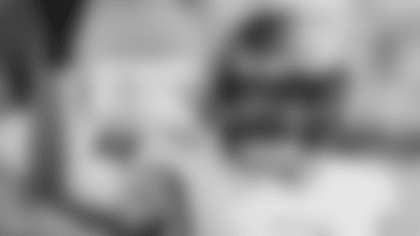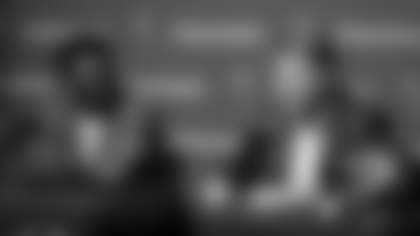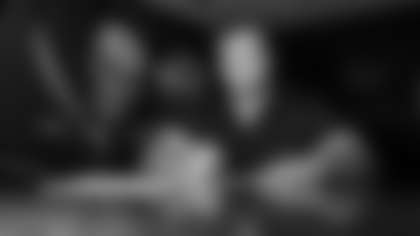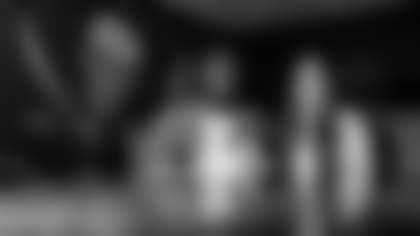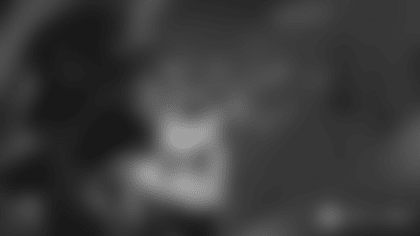RB Warrick Dunn, catching a pass in the end zone, is a potential 'red zone' target for the Bucs' offense
Monte Kiffin had a few numbers he wanted to run by the media on Wednesday.
Kiffin, defensive coordinator of the Tampa Bay Buccaneers and the de facto head man in the absence of Tony Dungy, ran down – from memory – the 'red zone' numbers of his defense and the Tennessee Titans' offense over the last few seasons. The numbers are very good. Kiffin was very excited.
Kiffin had just finished directing his second summer practice in a row, as Dungy, the team's head coach, was in Baltimore along with Offensive Coordinator Les Steckel for the NFL Spring Meeting. Steckel is in his first year with the Buccaneers after four years of leading a Titans' offense that commonly excelled in the red zone, though he prefers to call it the 'Green Zone'. Kiffin's defense routinely finishes near the top of the NFL in opponents' touchdown percentage. Together, Kiffin says, those two factors could make a lethal combination.
The red zone is defined as the area inside the 20 when an offense has advanced into its opponent's territory. It is generally considered an excellent scoring opportunity when a team can get that close, and the NFL stat sheets rank teams by what percentage of those opportunities they can turn into touchdowns. The Bucs spent much of Wednesday's workout on that aspect of the game.
"The red zone – I tell you what – it's very important," said Kiffin. "Yesterday we talked about third down, gotta win on third down. Today, we worked just as hard on the red zone. It's very important, and the players worked hard at it today.
"We always play good red zone defense, because what does that do? It cuts down on scoring. Seven points or three points…a difference of four points every time they're down there."
The Tampa Bay Buccaneers finished second in the NFL in red zone defense in 1999, allowing just 34.4% of opponent drives inside the 20 to result in touchdowns. That was back up from a not-too-shabby seventh place finish in 1998, which followed a league-best mark in 1997. Meanwhile, the Titans boasted the third-best red zone offense in the NFL in 1999, finding the end zone on 62% of their forays inside the 20. Tennessee didn't rank in the top 10 in that category in 1998, but they were the first team in league history to convert every red zone trip into some kind of score.
"Against our defense, (opponents) scored 11 touchdowns and 14 field goals (in the red zone)," said Kiffin. "See, that's good. Now, Tennessee's offense had 31 touchdowns and 14 touchdowns (in the red zone), so that's good, too. We put that combination together, we're going to be tough."
So, one day after the Bucs spent a larger-than-usual amount of time simulating third-down plays, on Wednesday they devoted most of the 90-minute workout to what happens inside the 20s. Kiffin wouldn't declare a winner between the offensive and defensive units, but did indicate that his defense remained strong. However, the final play of the team red zone drills featured WR Keyshawn Johnson catching a pass at the back of the end zone with his arms fully extended and his toes barely dragging the grass. It is considered a key element of the Bucs' desire to acquire Johnson (they traded two first-round draft picks for the former Jet in April) that the 6-4 Pro Bowler is a constant threat in the red zone.
The rest of the workout followed the general form that each of these voluntary summer practices has been built around. There are 80 of a possible 87 Buccaneers in Tampa for the NFL-sanctioned 'organized football activity', all of which come out on the field at approximately 10:20 a.m. for running and stretching. Individual position drills generally follow, particularly for the linemen, and the defensive line drills were bolstered on Wednesday by the return of DT Warren Sapp. Sapp, the 1999 NFL Defensive Player of the Year, sat out Tuesday's practice due to a sore right foot, but was back to his usual high-energy, high-volume self on Wednesday.
Backs, receivers, DBs, linebackers and tight ends generally spend the middle part of practice in a variety of five-on-five, seven-on-seven types of drills. For instance, on Wednesday, Eric Zeier and Joe Hamilton took turns throwing to receivers running routes one-on-one with defensive backs on the far field behind One Buccaneer Place while Shaun King tossed passes to running backs and tight ends covered by linebackers on the close field.
But all of that was a prelude to the central red zone theme on Wednesday, activity Kiffin hopes will give the team an edge by the time it opens training camp in late July. "The players are working hard," said Kiffin, who will relinquish his whistle on Thursday when Dungy returns. "I think I mentioned it yesterday, but it really is hot out here and our players are working hard. They don't have to be here. This time of the year is voluntary, so what we're doing is gaining an edge.
"I'm not putting anybody down, and all due respect to everybody else, but I don't know if anybody works any harder than our football team."





